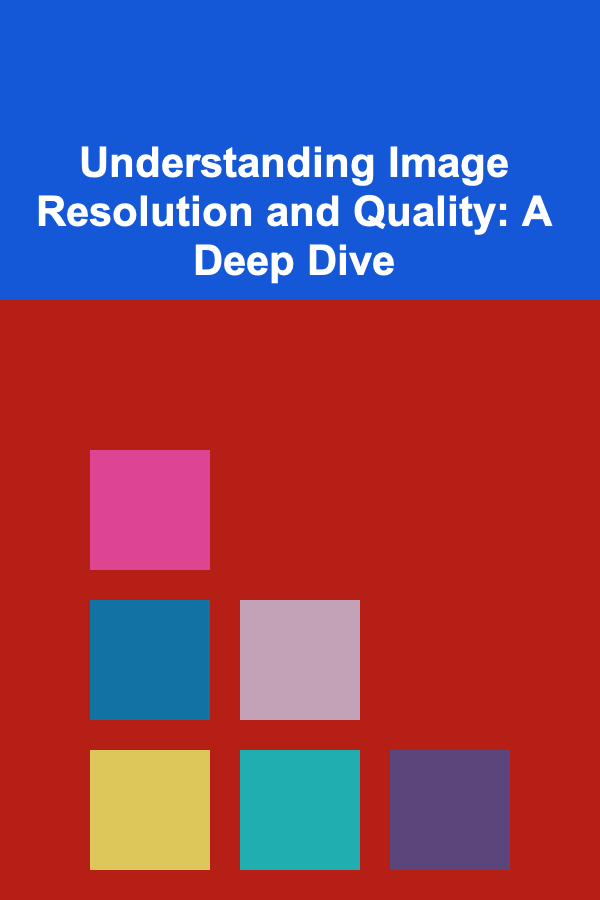
Understanding Image Resolution and Quality: A Deep Dive
ebook include PDF & Audio bundle (Micro Guide)
$12.99$5.99
Limited Time Offer! Order within the next:

In the digital age, images are ubiquitous. They populate our social media feeds, illustrate articles, and serve as crucial components of web design and marketing materials. However, not all images are created equal. The perceived quality of an image hinges on several factors, primarily resolution and the various attributes that contribute to overall visual fidelity. This article aims to provide a comprehensive understanding of image resolution and quality, exploring the key concepts and practical considerations that influence how we perceive and utilize digital images.
What is Image Resolution?
At its core, image resolution refers to the detail an image holds. It's most commonly expressed in terms of the number of pixels in an image, typically represented as width x height (e.g., 1920x1080). Each pixel is a tiny square of color, and the more pixels an image contains, the more detail it can display. Therefore, a higher resolution image generally looks sharper and more detailed than a lower resolution image.
Pixels, Resolution, and Image Size
It's crucial to distinguish between resolution and image size. While related, they are not synonymous. Resolution describes the pixel density, while image size refers to the physical dimensions of the image when printed or displayed. A high-resolution image can be printed at a larger size without appearing pixelated, whereas a low-resolution image will lose detail and clarity when enlarged.
For example, an image with a resolution of 640x480 pixels might look fine on a small smartphone screen. However, if you try to print it as an 8x10 inch photograph, it will appear blurry and pixelated. Conversely, a high-resolution image (e.g., 4000x3000 pixels) can be printed at a much larger size (e.g., 16x20 inches) while maintaining excellent detail and clarity.
Pixels Per Inch (PPI) and Dots Per Inch (DPI)
The terms Pixels Per Inch (PPI) and Dots Per Inch (DPI) are often used interchangeably, but they have distinct meanings. PPI refers to the pixel density on a digital display, while DPI refers to the dot density of a printed image. In essence, PPI describes the resolution of an image on a screen, while DPI describes the resolution of a printed output.
A higher PPI/DPI value means that more pixels or dots are packed into a smaller area, resulting in a sharper and more detailed image. For print, a standard DPI of 300 is generally recommended for achieving high-quality results. For digital displays, the required PPI depends on the screen size and viewing distance. Retina displays, for example, have a very high PPI, making individual pixels virtually invisible to the naked eye.
It's important to note that increasing the DPI of an existing image in image editing software will not magically improve its resolution. It simply tells the printer to use more dots per inch, potentially resulting in a smaller print size. To increase the actual resolution, you would need to either resample the image (which can introduce artifacts) or acquire a higher-resolution source image.
Factors Affecting Image Quality Beyond Resolution
While resolution is a crucial factor, it's not the sole determinant of image quality. Several other factors contribute significantly to how we perceive and evaluate an image:
Compression
Image compression techniques are used to reduce the file size of an image, making it easier to store and transmit. There are two main types of compression: lossy and lossless.
- Lossy Compression: This method reduces file size by discarding some of the image data. While this results in a smaller file, it also leads to a loss of quality. JPEG is a common example of a lossy compression format. Repeated saving and editing of JPEGs can further degrade image quality.
- Lossless Compression: This method reduces file size without discarding any image data. It works by identifying and eliminating redundancies in the data. PNG and TIFF are examples of lossless compression formats. Lossless compression preserves image quality, but the resulting file sizes are typically larger than those produced by lossy compression.
The choice between lossy and lossless compression depends on the intended use of the image. For images that need to be shared online or stored efficiently, lossy compression may be acceptable, especially if the compression ratio is carefully controlled. For images that require maximum quality, such as photographs for printing or artwork for archival purposes, lossless compression is generally preferred.
Color Depth
Color depth, also known as bit depth, refers to the number of bits used to represent the color of each pixel in an image. A higher color depth allows for a greater range of colors to be displayed, resulting in smoother gradients and more realistic color representation.
- 8-bit Color: This allows for 256 different colors (2^8^). It's often used for images with limited color palettes, such as GIFs.
- 24-bit Color (True Color): This allows for approximately 16.7 million different colors (2^24^), providing a rich and accurate representation of colors. It's the standard for most digital images, including JPEGs and PNGs.
- 32-bit Color: This is similar to 24-bit color but includes an additional 8 bits for alpha transparency, allowing for partially transparent pixels. PNGs often utilize 32-bit color for supporting transparency.
Using a higher color depth than necessary can increase file size without significantly improving image quality. However, for images with subtle color variations or gradients, a higher color depth can help to avoid banding artifacts.
Dynamic Range
Dynamic range refers to the range of tones in an image, from the darkest shadows to the brightest highlights. A wider dynamic range allows for more detail to be captured in both the shadows and highlights, resulting in a more realistic and visually appealing image. Images with limited dynamic range may appear flat and lacking in contrast.
High Dynamic Range (HDR) imaging techniques are used to capture and display a wider range of tones than is possible with standard cameras and displays. HDR images typically involve combining multiple exposures of the same scene to capture detail in both the shadows and highlights. HDR displays can then reproduce this wider range of tones, resulting in images with greater realism and impact.
Sharpness and Focus
Sharpness refers to the clarity and detail of the edges in an image. A sharp image appears crisp and well-defined, while a blurry image appears soft and lacking in detail. Focus is closely related to sharpness; an image that is in focus will generally appear sharper than an image that is out of focus.
Several factors can affect sharpness and focus, including the quality of the lens, the camera's focusing system, and camera shake. Post-processing techniques, such as sharpening filters, can be used to enhance sharpness, but they can also introduce artifacts if overused.
Noise
Noise refers to random variations in color or brightness that can appear as grainy or speckled patterns in an image. Noise is often caused by low-light conditions, high ISO settings, or sensor limitations. Excessive noise can degrade image quality and make it difficult to see fine details.
Noise reduction techniques can be used to minimize noise, but they can also soften the image and reduce detail. It's important to strike a balance between reducing noise and preserving sharpness.
Artifacts
Artifacts are unwanted distortions or imperfections that can appear in an image due to various factors, such as compression, processing errors, or sensor limitations. Common artifacts include:
- Pixelation: This occurs when an image is enlarged beyond its original resolution, resulting in visible individual pixels.
- Blocking: This occurs when lossy compression algorithms, such as JPEG, divide the image into blocks and compress them separately, resulting in visible block-like patterns, especially in areas with smooth gradients.
- Banding: This occurs when there are not enough color gradations to represent a smooth transition between colors, resulting in visible bands of color.
- Moire: This occurs when two regular patterns, such as the pattern of pixels on a sensor and the pattern of fabric in a subject, interfere with each other, creating wavy or distorted patterns.
Avoiding artifacts requires careful attention to image acquisition, processing, and compression. Using high-quality equipment, shooting in optimal conditions, and using appropriate compression settings can help to minimize artifacts.
Practical Considerations: Choosing the Right Resolution and Quality
Selecting the appropriate resolution and quality for an image depends on its intended use. Here are some practical considerations:
Web Images
For web images, file size is a critical factor. Large images can slow down page load times, which can negatively impact user experience and SEO. Therefore, it's important to optimize images for the web by reducing their file size without sacrificing too much quality.
- Resolution: Generally, images displayed on websites do not need to be excessively high resolution. A resolution that matches the display size of the image on the page is usually sufficient. For example, if an image will be displayed at 800x600 pixels, there's no need to use a much higher resolution image.
- File Format: JPEG is generally a good choice for photographs, while PNG is better for images with sharp lines, text, or transparency. Consider using optimized formats like WebP, which offers better compression than JPEG with comparable quality.
- Compression: Experiment with different compression settings to find the optimal balance between file size and image quality. Tools like TinyPNG and ImageOptim can help to reduce file size without significant quality loss.
Print Images
For print images, high resolution and quality are essential to ensure sharp and detailed results. The required resolution depends on the desired print size and viewing distance.
- Resolution: As a general rule, aim for a DPI of 300 for high-quality prints. For larger prints that will be viewed from a distance, a lower DPI may be acceptable.
- File Format: TIFF is a good choice for print images, as it supports lossless compression and can preserve high image quality. JPEG can also be used for print, but it's important to use a low compression setting to minimize artifacts.
- Color Space: For professional printing, it's important to use a color space that is appropriate for the printing process. CMYK is the standard color space for print, while RGB is used for digital displays.
Archival Images
For archival images, it's crucial to preserve the highest possible quality to ensure that the images remain usable for future generations. Lossless compression and high resolution are essential for archival purposes.
- Resolution: Scan or capture images at the highest possible resolution to capture as much detail as possible.
- File Format: TIFF is the preferred file format for archival images due to its lossless compression and support for metadata.
- Storage: Store archival images on durable media, such as hard drives or optical discs, and create multiple backups to protect against data loss.
Software Tools for Analyzing and Manipulating Image Resolution and Quality
Numerous software tools are available for analyzing and manipulating image resolution and quality. These tools can help you to assess image quality, optimize images for different purposes, and correct common image defects.
- Adobe Photoshop: A professional-grade image editing software that offers a wide range of tools for adjusting resolution, color, sharpness, and other image properties.
- GIMP (GNU Image Manipulation Program): A free and open-source alternative to Photoshop that offers many of the same features.
- ImageMagick: A command-line tool that can be used to perform a variety of image processing tasks, including resizing, converting, and optimizing images.
- Online Image Optimizers: Several online tools are available for optimizing images for the web. These tools typically offer a simple and convenient way to reduce file size without sacrificing too much quality. Examples include TinyPNG, ImageOptim (macOS), and compressor.io.
The Future of Image Resolution and Quality
Image resolution and quality are constantly evolving. As display technology advances, the demand for higher resolution images will continue to grow. 8K and even higher resolution displays are becoming increasingly common, pushing the boundaries of what is possible in terms of image detail and clarity.
Artificial intelligence (AI) is also playing an increasingly important role in image processing. AI-powered image enhancement algorithms can be used to improve image quality, reduce noise, and even increase resolution. These algorithms can learn from large datasets of images to identify and correct common image defects, resulting in more visually appealing and realistic images.
Furthermore, advancements in compression technology are enabling the creation of smaller and more efficient image files without significant quality loss. New compression formats, such as AVIF, offer better compression ratios than JPEG while maintaining comparable or even superior image quality. This allows for faster loading times and more efficient storage of images.
Conclusion
Understanding image resolution and quality is essential for anyone who works with digital images. By understanding the key concepts and practical considerations discussed in this article, you can make informed decisions about image acquisition, processing, and compression to ensure that your images look their best. From choosing the right resolution for web images to preserving the highest possible quality for archival purposes, a solid understanding of these principles will empower you to create and utilize images effectively.

How to Implement Soundproofing in Open-Concept Living Areas
Read More
How to Write High-Converting Video Scripts
Read More
How To Practice Mindfulness on the Road
Read More
How to Find Thought-Provoking Non-Fiction Books
Read More
How to Become a Coffee Connoisseur
Read More
10 Tips for a Business Plan That Attracts Investors
Read MoreOther Products

How to Implement Soundproofing in Open-Concept Living Areas
Read More
How to Write High-Converting Video Scripts
Read More
How To Practice Mindfulness on the Road
Read More
How to Find Thought-Provoking Non-Fiction Books
Read More
How to Become a Coffee Connoisseur
Read More